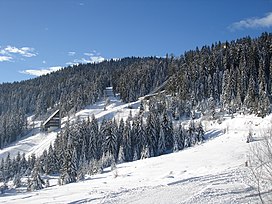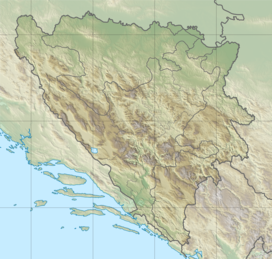Igman
| Igman | |
|---|---|
| Игман | |
 Igman in winter | |
| Highest point | |
| Elevation | 1,510 m (4,950 ft) |
| Coordinates | 43°44′N 18°09′E / 43.74°N 18.15°E |
| Geography | |
| Location | |
| Parent range | Dinaric Alps |
Igman (
Sports
During the 1984 Winter Olympics, Igman was, along with Jahorina and Bjelašnica, the location of the competition in the alpine and Nordic sports disciplines. Igman hosted primarily the Nordic disciplines; the Igman Olympic Jumps in the Malo Polje area were the site of the ski jumping events and also the ski jumping part of the Nordic combined events. Meanwhile, the Veliko Polje hosted the biathlon, cross-country skiing, and the cross-country skiing part of the Nordic combined event.[2] In preparation of the Games a road was constructed across the Igman plateau connecting Sarajevo through Hadžići to the Malo Polje, Veliko Polje and Babin Dol venues. There were numerous structures constructed on Igman at this time, although many stand destroyed or bear the scars of the 1992-1995 conflict. One of the most eye catching structures remains the Ski Jumping platform at Malo Polje.
Recent military history
World War II
Although the Igman area may probably have been the scene of military controversy in the earlier
Bosnian War
Mount Igman was usurped in the course of the
After the completion of the Sarajevo Tunnel under the airport in July 1993, the small unpaved forest road passing over Mt Igman became the sole important supply road into the besieged city. The ARBiH-controlled central plateau of Igman came under increased VRS pressure when the suspicion became stronger that the area had become a major logistical artery of the besieged city. A major VRS offensive started July 1993 and on August 4, 1993 Serb forces captured part of the Igman supply road.[3] The VRS advance was stopped under threat of NATO airstrikes.[4]
The area was declared a
Meanwhile, the ARBiH units remaining on the plateau were formally restricted to R&R activities, notably resulting in the building of the Igman Džamija, a wooden mosque in the forest, still much frequented today. The Igman supply road remained the almost exclusive supply route into Sarajevo until the end of the war. It was also the only entry and exit road for the Bosnian political leadership. Bosnian president Alija Izetbegović and foreign secretary Muhamed Sacirbey traveled through this road.[6]
Foreign negotiators tended to avoid the road as it was "often described as the most dangerous road in Europe".
By mid-1995 the military situation became very tense again, and in August 1995 the VRS launched another offensive forcing UNPROFOR from the Bjelašnica ridge and advancing again towards Veliko Polje. After the
Gallery
-
Ski jumping hills on Igman in spring
-
Sarajevo seen from Igman
-
Igman The former wartime supply road
-
Mt Igman French APC in which members of 1995 US Peace Mission perished.
-
Igman Hrasnicki Stan
-
view of Mt. Igman from Sarajevo
-
Ruins of Hotel Igman on the mountain
Skiing and hiking
Igman is nowadays a popular destination for
Other
At the very foot of the mountain, close to
One of the primeval forests of Bosnia and Herzegovina, Ravna Vala is also located on mountain Igman.
Igman Initiative
The Igman mountain, with its wartime legacy, has lend its name to a non-governmental/political initiative that is aimed at bringing the former belligerents in the region together. The mission of the Igman Initiative is to encourage normalization of the overall relations among the countries of the
References and footnotes
- ^ BiH Mine Action Centre (Annually updated) Mine Map
- ^ 1984 Winter Olympics official report. pp. 18-58, 106-7.
- ^ Milos Stankovic: Trusted Mole page 192-193 Harper Collins London paperback ed 2001
- ^ Mark A. Bucknam: Responsibility of Command, page 108-112, Air university Press, Alabama 2003
- ^ Steven L. Burg, Paul S. Shoup: The War in Bosnia Herzegovina: Ethnic Conflict and International Intervention page 142-144 M.E. Sharpe Inc. New York 2000
- ISBN 0-375-50057-X
- ISBN 0-375-50057-X
- ISBN 0-375-50057-X
- ^ Mark A. Bucknam: Responsibility of Command, page 279-288, Air university Press, Alabama 2003
- ^ Listing of mountain huts at www.behremplaninar.com
- ^ See: "BH MAC : News". Archived from the original on 2013-03-30. Retrieved 2012-10-30.
- ^ In an interview with Radio Free Europe one of the activist, Ivan Stambolic, said “because of the people in Sarajevo and solidarity with them, but also in support of the people in Serbia who have been against the war and destruction of the city and the people in it, but also because of war monger and instigators . . . with this act I want to show that patriotism, lest humanism, is a lie.”
- ^ At that time the Federal Republic of Yugoslavia (FRY) still consisted of Serbia and Montenegro.











